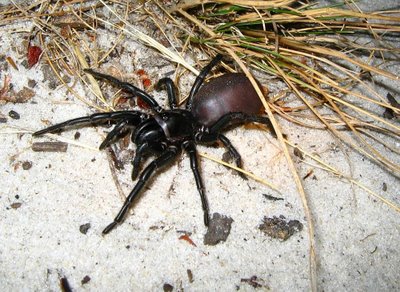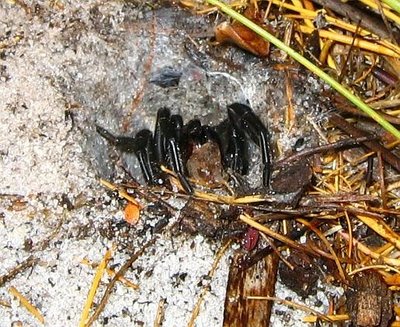




Bird-dropping Spider, Celaenia excavata
A nature study of the Esperance region of Western Australia.





Bird-dropping Spider, Celaenia excavata




Banded Orb-weaving Spider, Argiope trifasciata
The male banded spider is a fraction the size of the female (usually between a third and a quarter) and sometimes with other males, can be found on the outer edge of the web. It is very hazardous however being a suitor to the large female, as many males end up being her lunch; those that do escape often have to shed a leg or two to distract her in the process.
A fully intact male Banded Spider
A male Banded Spider who has lost the back legs escaping the female
For reasons possibly related to nursery duties, the female will leave her web unattended. On one such occasion a very bold male took her place in the centre of the web, but alas his triumph was short lived, as next day he looked like a silk-wrapped snack.
The female Banded Spider snacking on the unfortunate male
Despite having very effective venom for paralysing invertebrates, banded spiders are harmless to humans preferring to flee and play dead rather than bite. And unless you are looking in the right place, you will probably never see one, but should you be so lucky, it is worth checking this spiders activities daily, for besides being very colorful, they are also interesting to know.
The underside of the female Banded Spider, note the broad spinneret region for fast wrapping
 Wolf Spider Hogna immansueta
Wolf Spider Hogna immansuetaA spider often confused with the Wolf Spider is the Nursery-web Spider from the family Pisauridae. Many have similar coloration to the Wolf Spider, but their eye arrangement is the main feature that separates them. Their eyes are arranged in two rows of 4 with the top row strongly recurved. The size of the eyes are similar, or the top row slightly larger. Another difference (can be seen in the photo below) is the female carries her egg-sac directly beneath her body, whilst the wolf spider trails it behind her.

Below is another Pisauridae species, this one is commonly found on low-lying clumps of twigs waiting for insects to come within range. This species is much smaller than most wolf spiders, but can move quite quickly to catch its dinner. Like the wolf spider, these nursery-web spiders also reflect a torch light when shone in their eyes. So just scanning around with your torch held just below your eyes, you can pick them out from over 10 metres away, which is an effective method to judge their population size and preferred habitat.

Modern ground dwelling araneomorph spiders, come from several families. They are hunters, do not construct a web, but some will construct a small daytime or nursery retreat and all protect their eggs in a structure made from silk web material produced from their spinnerets. Because they do not catch their prey in a web, they must restrict themselves to prey they can physically overcome, which generally would be smaller invertebrates, although with some aquatic spiders, vertebrates are also taken.
The same pisaurid species as above, but this one pretending to be an octopus. :)

Yet another Pisauridae species that is still a nursery-web spider, but is more commonly known as a Fishing Spider from the genus Dolomedes and is one of about a dozen species. This one is distinctively colored being dark brown with cream stripes. They move around easily on the surface film of still water, but can dive under to hunt small fish, tadpoles and aquatic insects. They will do the same to avoid predators. Body length is around 2 cm, making them among the largest of this group.
Fishing Spider a Dolomedes species
Although a Fishing Spider, they do not need water to survive. In my area the swamps usually dry completely during summer, it is then this spider may be found further afield. The one below I discovered in my outside bathroom, where she had decided to build her nursery-web on the ground between an old washing machine and a piece of corrugated iron.

Below is part of her nursery-web, here the spiderlings (100 plus) have hatched and after a week had ballooned off on the wind to make a life for themselves. However mum stayed with them until this period.
Below is one of the reasons mum stays with the kids, a Daddy-long-legs (Pholcidae species), is intent on gobbling up a few. This it did for a couple of days until mum noticed it, where upon it ended up a snack for her.

Another ground spider below is from the family Miturgidae and the genus Miturga (my thanks to the WA Museum for identification), it is part of a large group, some Australia wide. They build silken retreats to moult or produce egg-sacs. Some also construct a lose web framework amongst twigs near the ground.

Miturga species
It is interesting to note the legs on most of these ground spiders. They are usually strong and longish and used for running down and holding prey, but their size and arrangement is interesting. With most spiders at least one of more pairs of legs are longer than the others, plus they are usually arranged so some face forward and the others backwards. You can see with these spiders, that when at rest their legs are about the same length and arranged evenly like spokes in a wheel.
The spider below is an Argoctenus species from the family Zoridae (my thanks to the WA Museum for identification) and has just caught a moth. Spiders in this family generally hunt amongst low vegetation or leaf-litter. It is another species that looks like some members of Lycosidae the wolf spiders, except the legs tend to be more slender.
Yet another ground dwelling spider, but this one very small, the body length would be no more than 5 mm, but it is extremely fast. I have no idea to which this species belongs, but I am not alone here, as there are so many ground dwelling spiders you need an expert to tell the difference between families, let alone between genera and species. So next time you see a similar shaped spider on your veranda, have a closer look. You may not be able to positively identify it, but now you should see there are different species, which make up a part of your fascinating garden eco-system.


Another male finishing off a beetle.




 White-tailed Spider a Lampona species
White-tailed Spider a Lampona species






Aname species - Black Wishbone Spider
Her body length can exceed 3 cm and if disturbed is usually very aggressive.


Below she is carrying/bulldozing sand from her burrow.

 The male of this species whilst looking for the ladies, can be found wandering around at night, particularly after rain in spring and autumn. Being smaller, he needs to protect himself from being regarded as prey from the much larger and heavier female, this he does by restraining her with strong spurs on the front legs that can be seen in the photo below.
The male of this species whilst looking for the ladies, can be found wandering around at night, particularly after rain in spring and autumn. Being smaller, he needs to protect himself from being regarded as prey from the much larger and heavier female, this he does by restraining her with strong spurs on the front legs that can be seen in the photo below. The male although smaller in body size, have very large fangs and should not be messed with. Although the venom from this species is not as toxic to humans (no known fatalities) as the Sydney Funnel-web, they can still inflict a very deep and painful bite.
The male although smaller in body size, have very large fangs and should not be messed with. Although the venom from this species is not as toxic to humans (no known fatalities) as the Sydney Funnel-web, they can still inflict a very deep and painful bite.